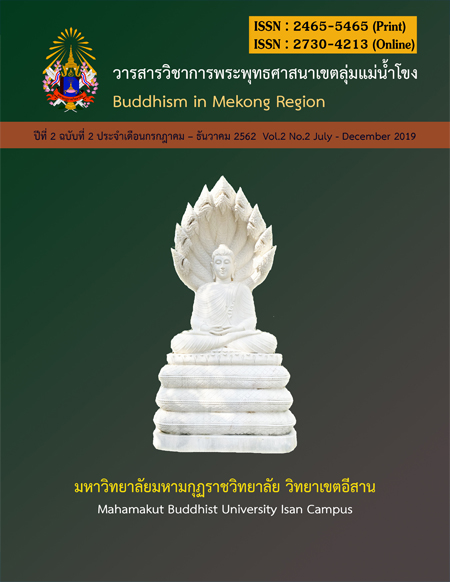Ven. Maha Ghosananda’s Contributions to Social Well-Being in Cambodia
Main Article Content
บทคัดย่อ
Cambodia is a Theravada country, which estimates to be 95 percent of its population are the follower of the Buddha; and where the monks hold an important place in the society at large. Buddhism is a part of the development in the social order, and it’s strongly played as social well-being in Cambodia. However, presently, social well-being is very important to the Cambodian Society and its people. But unfortunately, from April 17, 1975 to January 1979, social well-being in Cambodia was entirely destroyed by the Khmer Rouge. Due to the fact that the Khmer Rouge starved people to death and isolated the country from other countries, Cambodia and its population were suffering beyond one’s imagination; millions of people died from this civil war. Many monasteries were destroyed, and monks were killed and forced to lay lives. In addition, both public and private schoolings were impasses. After the Khmer Rouge Regime, Buddhism was re-established, and slowly began to increase with the re-ordination of Buddhist Monks who ran away from monasteries during the purges. They came back to monasteries re-establish and re-build monasteries with the supporting of lay Buddhist. Buddhism in Cambodia has deeply flourished after the Khmer Rouge era through the hard work of the Buddhist monks, especially Ven. Maha Ghosananda. Buddhism in Cambodia is divided into two sects: Mahānikaya and Dhammayutanikaya. Cambodian Buddhism has been growing and developing in the country under the leadership of Buddhist monks and lay Buddhists.
Article Details
- ผลงานที่ส่งตีพิมพ์จะต้องไม่เคยเผยแพร่ในสิ่งตีพิมพ์อื่นใดมาก่อนและต้องไม่อยู่ในระหว่างการพิจารณาของวารสารอื่น การละเมิดลิขสิทธิ์ถือเป็นความรับผิดชอบของผู้ส่งบทความโดยตรง
- ต้นฉบับที่ส่งตีพิมพ์ต้องเป็นภาษาไทยหรือภาษาอังกฤษเท่านั้น
- ต้นฉบับต้องผ่านการกลั่นกรองโดยผู้ทรงคุณวุฒิและได้รับความเห็นชอบจากกองบรรณาธิการ
- ในกรณีที่เป็นบทความแปล ต้องได้รับอนุญาตจากเจ้าของลิขสิทธิ์ โดยการขออนุญาตให้เป็นไปตามหลักจริยธรรมสากล
- ข้อความ เนื้อหา รูปภาพ และตาราง ที่ตีพิมพ์ในวารสาร เป็นความรับผิดชอบของผู้เขียนบทความแต่เพียงผู้เดียว มิใช่ความคิดเห็นและความรับผิดชอบของกองบรรณาธิการวารสาร กองจัดการ และมหาวิทยาลัยมหามกุฏราชวิทยาลัย วิทยาเขตอีสาน
6. ผลงานที่ได้รับการตีพิมพ์ถือเป็นลิขสิทธิ์ของวารสาร
เอกสารอ้างอิง
Green, S. (1981). “Calm in Chaos: Monk Keeps His Peace Through Terrors of Cambodia”, The Burlington Free Press, 1 October.
Hallisey, C. & Hansen, A. (1999). “Narrative, Sub-Ethics, and the Moral Life”, The Journal of Religious Ethics: 305-327.
Harris, I. (2001). “Saṅgha Groupings in Cambodia”, Buddhist Studies Review, UK Association for Buddhist Studies, 18 (I): 65–72.
Howard, K. & Greene, P. D. et tal, (2002). “Buddhism and the Musical Cultures of Asia: A Critical Literature Survey,” in The World of Music,Vol. 44, No. 2, (Body and Ritual in Buddhist Musical Cultures), 135-175.
Khemacaro, Y. H. (1998). “Steering the Middle Path: Buddhism, Non-Violence and Political Change in Cambodia”, Safeguarding Peace: Cambodia’s Constitutional Challenge, Special Issue, Accord 5: 73.
King, S. (2005). Being Benevolence: The Social Ethics of Engaged Buddhism, Honolulu: University of Hawaii Press.
Moser Paungsuwan, Y. (1992). “One Million Kilometres for Peace” and Liz Bernstein, “Buddhism and Conflict Resolution Seminar for Cambodians”. Phnom Penh: Unpublished papers.
Speech by Samdej Preah Maha Ghosananda on the occasion of “International Peace Day, and Cambodian Festival Pchum Ben”, in the Dammayietra Center for Peace and Non-violence, (1995).
Sovanratana, K. (2016). Contours of the Reconstruction of Buddhist Education in Cambodia after the fall of the Khmer Rouge, Ph.D Thesis, University of Delhi, India.
Thera, V. N. (trans.), (1971). The Dhammapada Verse 1.
Queen, C. (2003). Action Dharma: New Studies in Engaged Buddhism, Damien Keown, Charles Prebish (eds.), London: Routledge.


